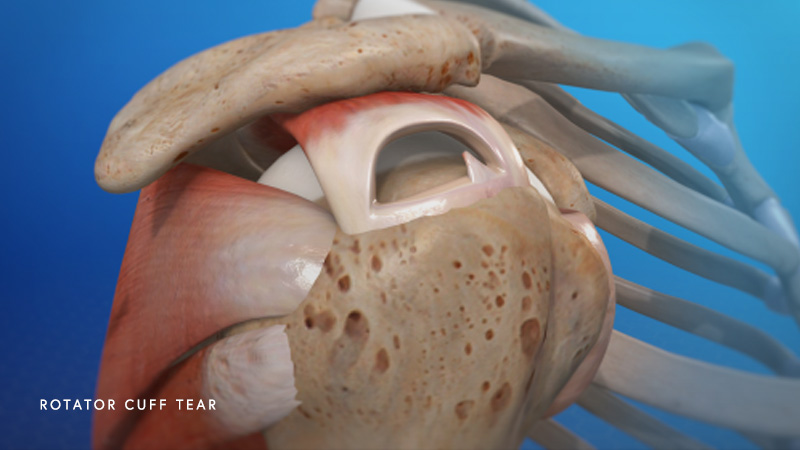Rotator Cuff Tear
Rotator cuff tears occur in the muscles of the ball and socket joint of the shoulder. These tears can either be complete ruptures of the muscle or partial tears. A partial tear occurs when one of the tendons of the rotator cuff becomes frayed or slightly damaged. A complete tear is a total rupture of one of the muscles or tendons of the rotator cuff.
The rotator cuff refers to the group of muscles and tendons that surround the ball-and-socket joint of the shoulder where the humerus meets the scapula. The rotator cuff is made up of four muscles that all end in short and flat tendons which unionize with the fibrous capsule in order to form the musculotendinous cuff. This intimate fusion occurs anywhere from ½ to ¾ of an inch from the point of insertion of the tendons into the humerus. The components of the rotator cuff are as follows:
- Subscapularis Muscle – This muscle is a large flat structure of the scapula whose tendon fibers blend with the fibrous capsule lateral to the glenoid brim (the socket of the shoulder). In addition, many of the fibers of this muscle insert directly into the shaft of the humerus below the tendinous insertion.
- Infraspinatus Muscle – This muscle derives from the axillary border on the posterior of the scapula. It is associated both structurally and functionally with the teres minor muscle.
- Teres Minor Muscle – This muscle is also derivative of the axillary border of the scapula. Its tendon along with the capsule inserts into the greater tuberosity. Much like the subscapularis muscle, the tendons of this muscle insert directly into the shaft of the humerus.
- Supraspinatus Muscle – This muscle originates from the supraspinous fossa and fuses with the capsular fibers and inserts into the greater tuberosity just posterior to the bicipital groove of the humerus.
A rotator cuff tear can either be a complete or partial tear of one of the four muscles that surround the ball-and-socket joint of the shoulder. A rotator cuff injury may cause a dull ache or pain in the shoulder joint, which often becomes worse with use. These types of tears are common and tend to increase in likelihood with age. Rotator cuff tears are most common in those whose occupation requires repeated overhead motions or in pitchers in baseball. Rotator cuff tears may occur as the result of a single injury.

Injuries to the rotator cuff are common in occupations and sports that require significant and repetitive overhead motions. These injuries may occur as the result of a substantial injury or deterioration or degeneration of tendon tissue in the shoulder. There are many groups that are at higher risk of rotator cuff tears than others. These groups are as follows:
- Baseball players
- Football quarterbacks
- Tennis players
- Basketball players
- Volleyball players
- Golfers
- Individuals 60 years or older
- Carpenters
- Painters
- Competitive weightlifters
- Those who are genetically susceptible
Dull and sharp pain in the ball-and-socket joint of the shoulder are the most common symptoms of a tear in the rotator cuff. These symptoms may often:
- Disturb sleep
- Be described as a dull ache in the shoulder
- Limit range of motion
- Make reaching behind the back difficult
- Cause arm weakness
During a physical exam, the physician will often test the shoulder’s range of motion and ask the patient if there is any pain or stiffness associated with the movement. The physician will also feel the affected area for tenderness. They will also run a series of tests in order to determine the overall strength of the shoulder.
If a diagnosis cannot be rendered from a physical exam, imaging tests are often ordered. XRays can rule out bone spurs, arthritis, and other potential causes of pain. However, the rotator cuff itself will now show up on an XRay. MRIs use radio waves to display images of the structures of the shoulder in detail. Ultrasounds will generate images of soft tissue in the rotator cuff and are the most common type of imaging used when diagnosing an injury to the shoulder.
The R.I.C.E. method (rest, icing, compression, and elevation) has been known to alleviate symptoms and heal minor injuries to the rotator cuff. Physical therapy is a common recommendation that strengthens muscles in the rotator cuff and extends the dexterity and range of motion in the shoulder. If conservative treatment methods do not work, and symptoms persist, surgery is often recommended.
Arthroscopic Tendon Repair
This form of repair utilizes an insertion of a small camera and surgical tools into the affected area. In this procedure, the torn tendon is reattached to the bone.
Open Tendon Repair
This surgery requires the surgeon to work the affected area through a large incision to reattach the tendon to the bone.
Tendon Transfer
During a tendon transfer, if the tendon is too damaged to be reattached to the humerus, surgeons may decide to use a tendon from a donor as a replacement.
Shoulder Replacement
A shoulder replacement is recommended for monumental rotator cuff injuries. In this procedure, a reverse shoulder arthroplasty is used to improve the artificial joint’s stability. This surgery installs the ball part of the artificial joint onto the scapula and the socket part onto the humerus.
If you or a loved one are currently experiencing any symptoms related to a rotator cuff tear, or have been diagnosed and require surgery, reach out to the experts at the Center for Orthopaedic Specialists. The Center for Orthopaedic specialists have been assisting the citizens of Ventura County and Los Angeles with rotator cuff injuries for many years. Contact us today!




 / 50 Reviews
/ 50 Reviews